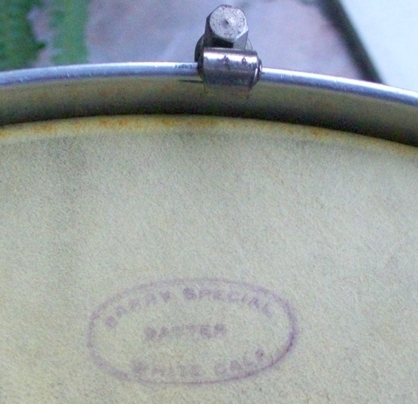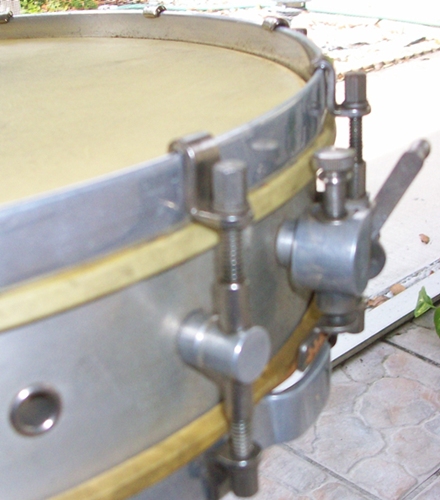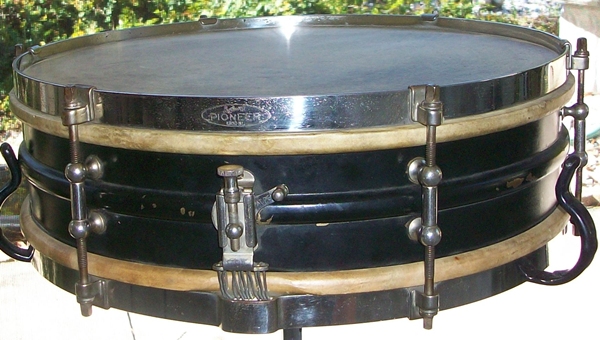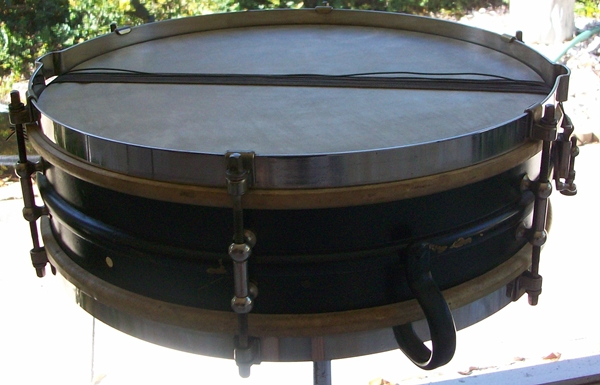Friday, December 18, 2009
More about the Barry Snare Drum
A member who goes by the screen name of 1967flyer on Drum Forum informed me that the snare drum model I have is called the Companion Drum. Here is the message, which is interesting in that his daughter - a percussionist - has the same model plus an impressive collection of Barry drums she uses.
Wednesday, December 16, 2009
Thoughts about snare wires
Many of my snare drums have Puresound Custom 16-strand wires, while some have Puresound 12-strand wires. I rarely go over 16 strands because I prefer the sound. These days when I need 16-strand wires I have started using the Worldmax German Steel model, which I think is the equal of Puresounds at a fraction of the price. My source is Best Drum Deals.
I have also used Grover wires (and like them for some applications), but keep coming back to Puresounds when I need a special wire like their 12- and 8-strand models. Both are excellent for snare drums with narrow and shallow snare beds, such as many Ludwig drums both vintage and modern. You may think that 8 strands is not enough, so maybe this review of Puresound's model 221 wires will be informative.
When it comes to vintage snare drums, such as Radio Kings, older Ludwig Supersensitives (and even modern ones), Dynasonics, etc., I first look to Puresound - here is their vintage snare wire page with the older 1920-1968 Supersensitive selected. Use the pulldown to see other models.
Since I am fairly set in my ways, and there are a lot of quality wires out there, I suggest that you pay a visit to James Walker's snare wire comparison page and check out his research.
If you have questions regarding selecting the right wires don't hesitate to contact me. If I don't have the answer I can point you in the right direction.
I have also used Grover wires (and like them for some applications), but keep coming back to Puresounds when I need a special wire like their 12- and 8-strand models. Both are excellent for snare drums with narrow and shallow snare beds, such as many Ludwig drums both vintage and modern. You may think that 8 strands is not enough, so maybe this review of Puresound's model 221 wires will be informative.
When it comes to vintage snare drums, such as Radio Kings, older Ludwig Supersensitives (and even modern ones), Dynasonics, etc., I first look to Puresound - here is their vintage snare wire page with the older 1920-1968 Supersensitive selected. Use the pulldown to see other models.
Since I am fairly set in my ways, and there are a lot of quality wires out there, I suggest that you pay a visit to James Walker's snare wire comparison page and check out his research.
If you have questions regarding selecting the right wires don't hesitate to contact me. If I don't have the answer I can point you in the right direction.
Update: 1920's Barry Drum Manufacturing Co. Arrived
The Barry snare drum I cited in my 8 December post arrived today. This is a fairly rare snare drum that is historical for a number of reasons. First is in In The great American drums and the companies that made them, 1920-1969 By Harry Cangany Harry states that he had only seen three Barry snare drums. Second, this snare drum is all original and in pristine condition. It also came with a canvas bag that doesn't look a day over one year old like the snare drum itself.
The dimensions are an interesting 2.5" deep (shell) x 13" diameter. I tried a brand new 13" Remo Coated Ambassador head on the batter side and it was a perfect fit. A drum key will not fit the tension rods - this is a function of how close the rod caps are to the hoop (see last photo). Modern drum keys are too thick to fit between the gap.
I prefer playing snare drums I collect, but given the rarity of this one and the pristine condition I am going to relegate it to display only. It is far too nice a specimen to expose to the wear and tear of even casual drum playing.
The rest of the story in pictures:






The dimensions are an interesting 2.5" deep (shell) x 13" diameter. I tried a brand new 13" Remo Coated Ambassador head on the batter side and it was a perfect fit. A drum key will not fit the tension rods - this is a function of how close the rod caps are to the hoop (see last photo). Modern drum keys are too thick to fit between the gap.
I prefer playing snare drums I collect, but given the rarity of this one and the pristine condition I am going to relegate it to display only. It is far too nice a specimen to expose to the wear and tear of even casual drum playing.
The rest of the story in pictures:
Shot showing badge

Original head!

Unique Throw-off

Butt Assembly

Bottom View - those gut snares look brand new

Tension rod detail

Tuesday, December 15, 2009
Update: Ludwig Pioneer snare drum has arrived!
In my 7 December post I was elated about getting two vintage Ludwigs. The Pioneer arrived yesterday.
It is a 4x14 vs. the 5x14 that the seller claimed, and it is the lighter shell, not the heavy two-piece. I very carefully tensioned it up last night to try her out without putting a stick through 80+ year old calf heads and was surprised by how soft she sounded. Most of my modern 4x14s are LOUD. Not so this one.
I tried a modern head and it was a perfect fit, but I am going to follow nittanyperc's excellent advice to condition the heads and keep them intact. (I will also quote it below in case you cannot get to the site.) I am also going to keep the gut snares, but need to do some better tensioning and straightening the strands out. The throw was a surprise - it actually functions perfectly (a rare thing!)
The drum has black over brass with brass showing through, which means that it could be one of the enamel 1930s models. I am pretty pleased and will use it when I need to play at PP or PPP or do killer press rolls (which it does well.) Not something one would drag to any gig requiring a modern sound or projection, but it will get played.



nittanyperc's excellent advice
It is a 4x14 vs. the 5x14 that the seller claimed, and it is the lighter shell, not the heavy two-piece. I very carefully tensioned it up last night to try her out without putting a stick through 80+ year old calf heads and was surprised by how soft she sounded. Most of my modern 4x14s are LOUD. Not so this one.
I tried a modern head and it was a perfect fit, but I am going to follow nittanyperc's excellent advice to condition the heads and keep them intact. (I will also quote it below in case you cannot get to the site.) I am also going to keep the gut snares, but need to do some better tensioning and straightening the strands out. The throw was a surprise - it actually functions perfectly (a rare thing!)
The drum has black over brass with brass showing through, which means that it could be one of the enamel 1930s models. I am pretty pleased and will use it when I need to play at PP or PPP or do killer press rolls (which it does well.) Not something one would drag to any gig requiring a modern sound or projection, but it will get played.



nittanyperc's excellent advice
The single best thing from them would be plain old water. If the heads are on wooded flesh hoops the hoops can warp from being subjected to the water after a time from being so dry. The key is regaining the "collar" on the head.
My advice would be to use an old plastic head, several sizes larger than the calf heads. Put some warm water into the old head (head is upside down) and place the calf head in it to soak up the water. Let the head slowly dry in a dark place and repeat as necessary. If you wet it enough, you can remove the head from the flesh hoop and re-tuck it. If you don't want to do that, make sure if you want to use the heads, to make sure that the tucked part of the head gets some hydration. I would start with just enough water to cover the plastic head, and gradually add water per a cycle or wetting the head and letting it dry. I'd leave the calf head in the water for like an hour or so before removing it to dry. Doing this a couple of times slowly should hopefully restore the pliability in the head.
As for the pinhole, you can probably ignore it, or I would use a small circle of moleskin (no larger than a dime) on the underside of the head. I'd perhaps use a concert tom or something to bring the head to just above finger tight before adding the moleskin, this way, the moleskin can move with the head as it is tensioned and released.
I know of some orchestral musicians, who will take a freshly tucked head, and install it on the drum they intend on using it on (still wet) and tension the head a little bit so the collar of the head forms to the bearing edge of the drum. Not sure if you need to do that, but it has worked for others.
Subscribe to:
Comments (Atom)